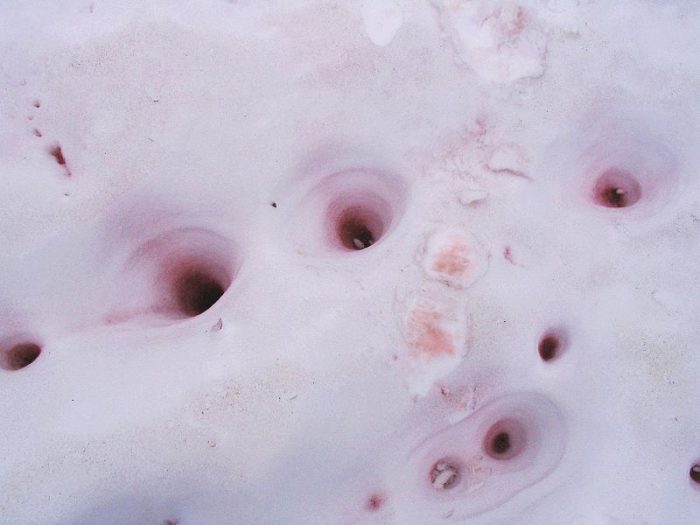When we see a bunch of snow stained red — and that it is being called 'blood snow' — our first thoughts aren't great. But as it turns out, this phenomenon has nothing to do with actual blood (phew!), and everything to do with... algae?
That's right — a peculiar green algae is staining the snow red near Vernadsky Research Base, a Ukrainian station in Antarctica. And that's not all that's new down south either!
But one thing at a time...
From green to red

Blood snow, or watermelon snow, can be found in many Arctic and Alpine areas. (Wikimedia Commons/Will Beback)
First, the blood snow. Chlamydomonas nivalis (say klah-MIH-doh-moh-nahs NI-vah-lihs) is a tiny green algae that is basically a single-celled seaweed that is found in polar and high mountain areas. Most of the time, it remains dormant, or asleep, inside freezing ice and snow. But when the sun comes around and temperatures warm up, then the party begins!! (Algae: They're Just Like Us!)
As the ice and snow melts, the water causes the algae to bloom — and that's when something very curious happens. To survive the ultraviolet radiation of the Sun, the algae develops a layer of red carotenoids for protection. This is the same sort of stuff that makes carrots, tomatoes, and pumpkins the colours that they are.
And in this case, it turns the snow the colour of a watermelon slushie! (By the way, for another story of bizarre coloured snow, click here)
Hey guys! There's an island under here!
And that's not all that Antarctica has been throwing our way lately. The Thwaites Glacier Offshore Research project (THOR) has been spending the last two years sailing near the Thwaites and Pine Glaciers on Western Antarctica. As climate change brings warmer temperatures, these are two of the quickest melting glaciers on the continent. Scientists believe that understanding what is happening here will give them a better understanding of how glaciers melt.
And sometimes as they melt, they reveal an island!
After being the first visitors, we can now confirm that Sif Island is made of granite and that it is covered by remnant ice shelf, and a few seals. Photos by CD Hillenbrand (BAS) and Laura Taylor (UH). @glacierthwaites @glacieroffshore @GAViglione #nbp2002 @BAS_News @UHEAS pic.twitter.com/dtWtdI95tL
— Julia Smith Wellner (@houston_wellner) February 23, 2020
For now, the 'new' piece of land is named Sif Island, a lesser-known character in Norse mythology. The island is truly small — about 350 metres (1,150 feet) long — and was previously completely hidden by ice. In fact, scientists think that it may have even been under sea level for a while, too. Glaciers weigh an immense amount — they not only cover the land underneath, they also push it down. When the glacier melts or retreats, 'glacial rebound' can occur, allow the ground that was once underneath to 'bounce' back up.
Can we expect more islands like Sif Island to 'pop up' if the melting continues? It's possible, and the THOR team are probably perfectly positioned to find out. Until then, Antarctica has given us more than enough interesting news to chew on!
 Watermelon slushies anyone? Actually seriously, do not eat this snow! (© National Antarctic Scientific Center of Ukraine/Andrey Zotov)
Watermelon slushies anyone? Actually seriously, do not eat this snow! (© National Antarctic Scientific Center of Ukraine/Andrey Zotov)










cool!
I call dibs!
That’s really fascinating! ?
Blood, so joking
coolish but not so cool 🙄